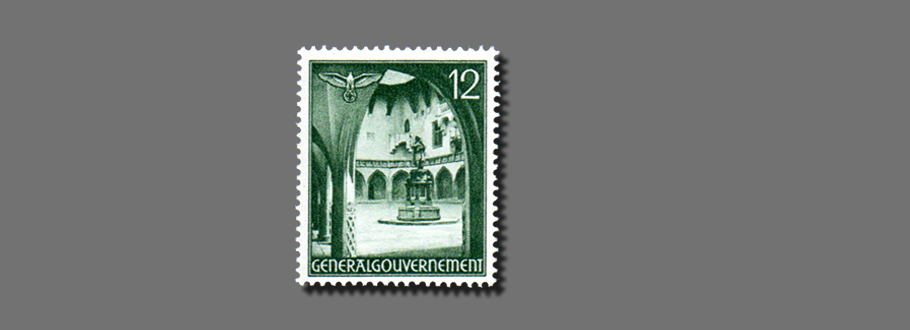
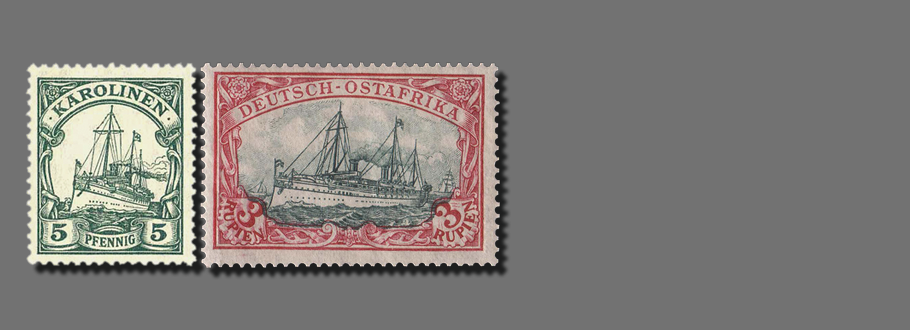
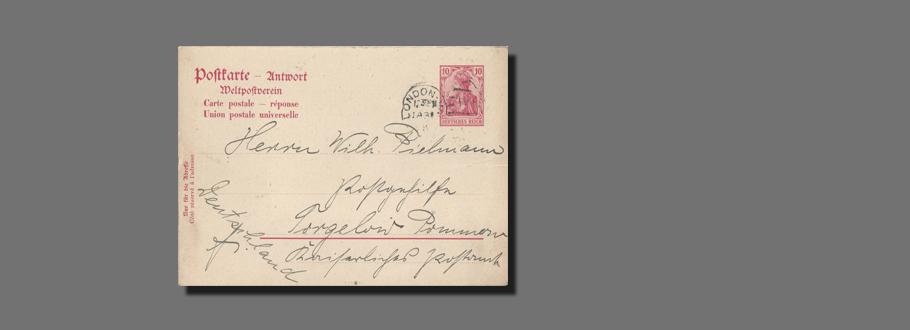
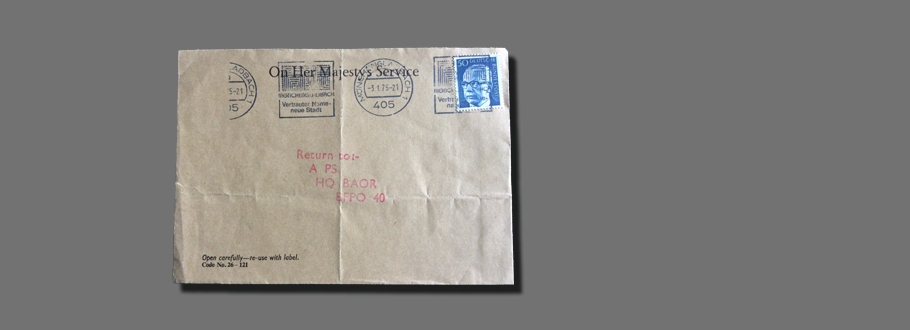


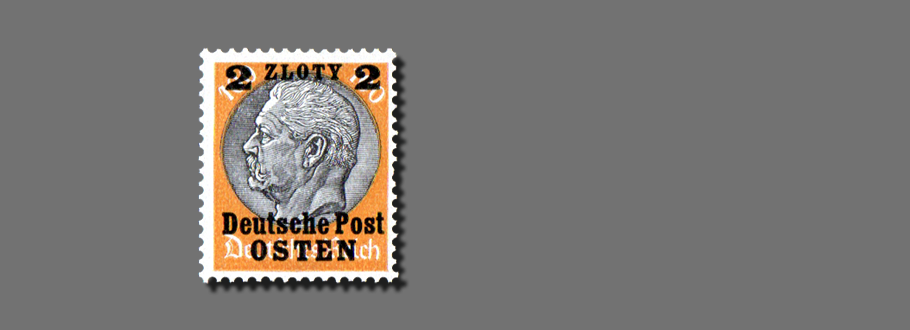
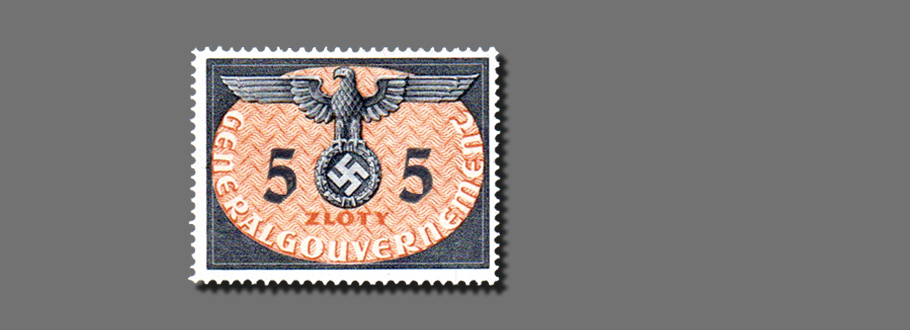
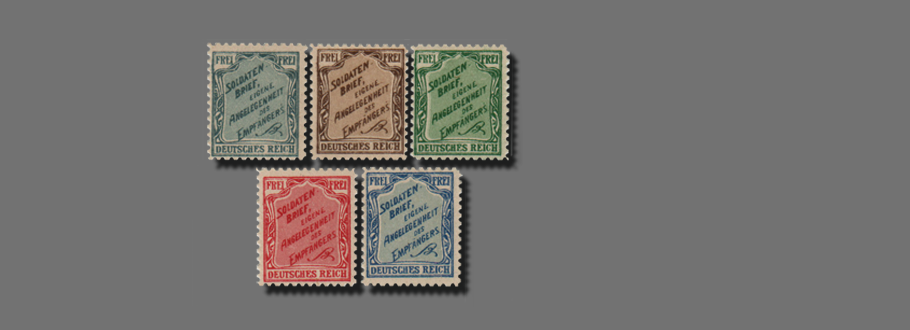

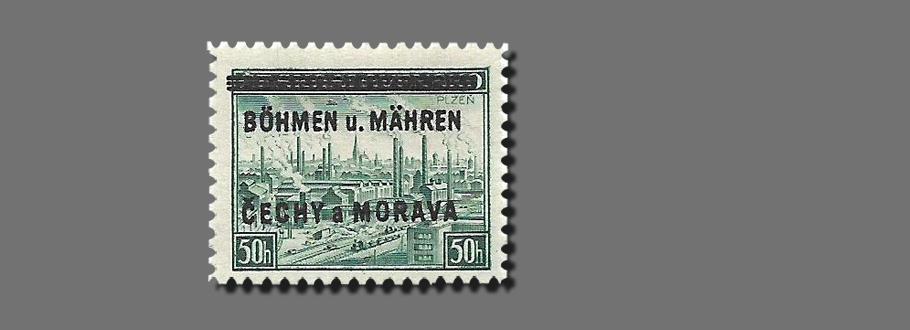
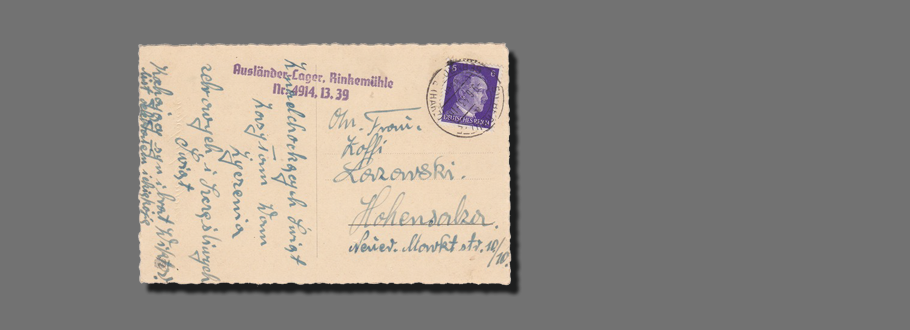
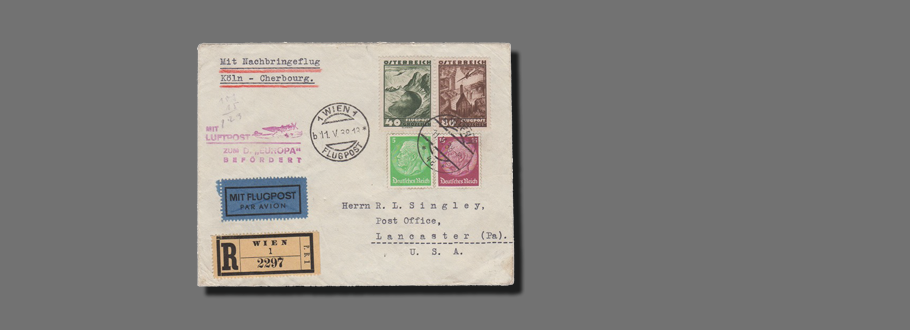
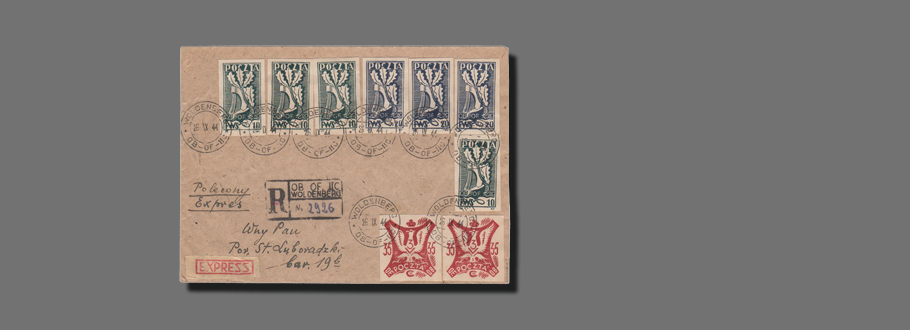
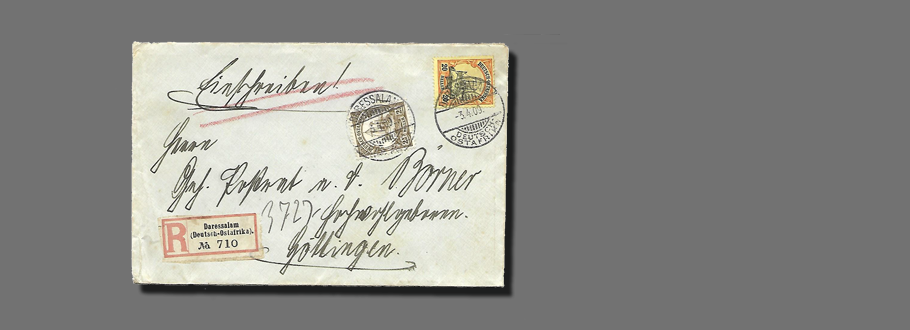
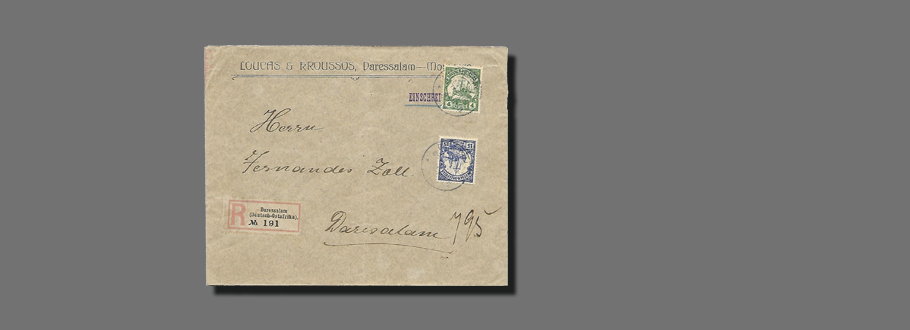
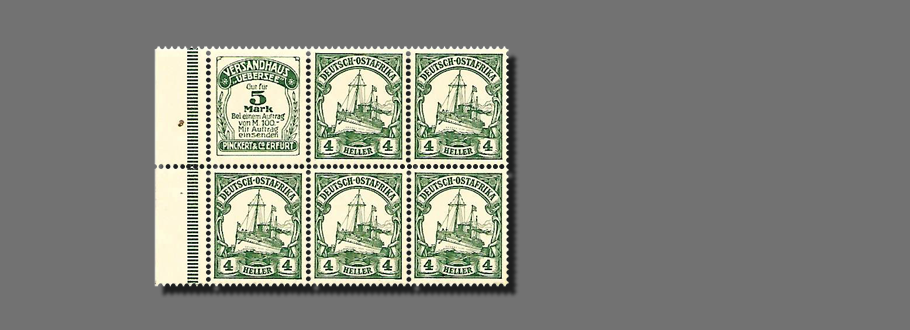

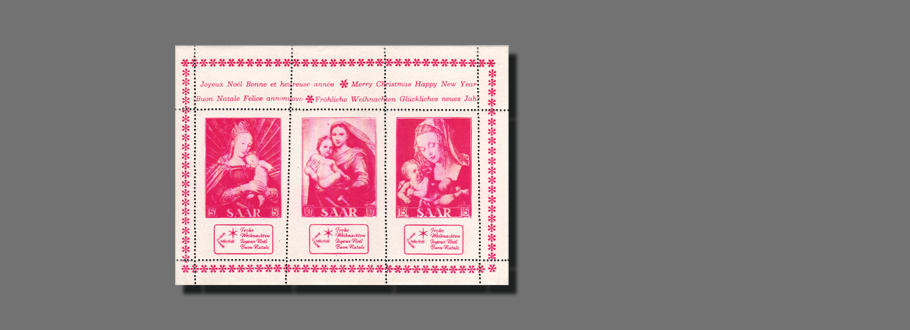
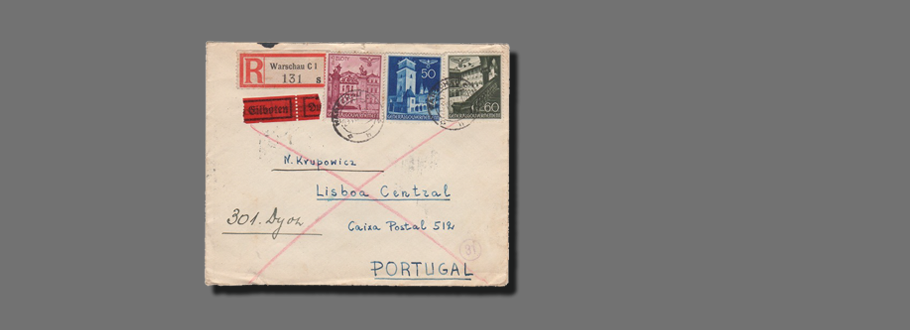


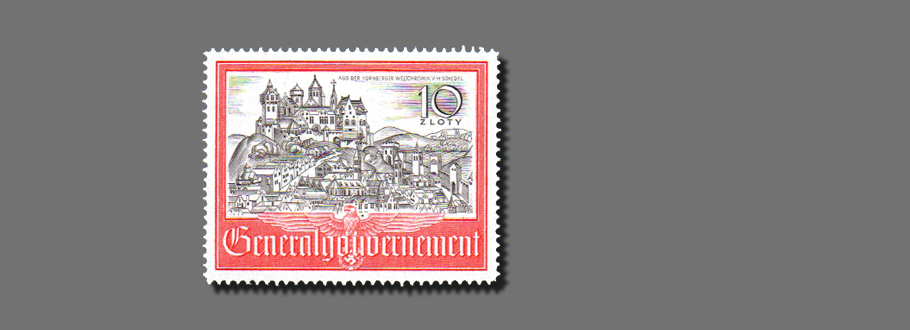

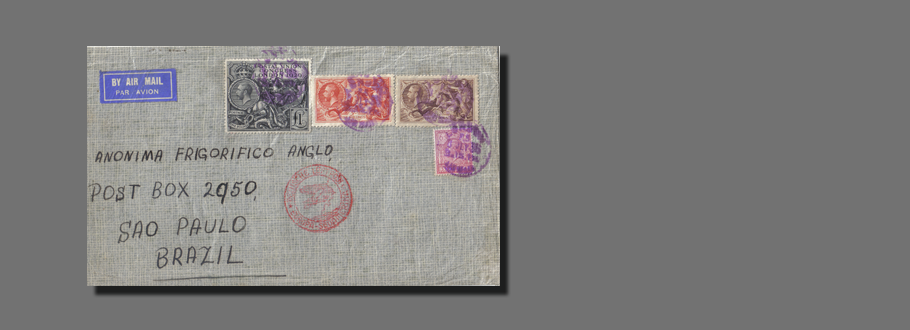
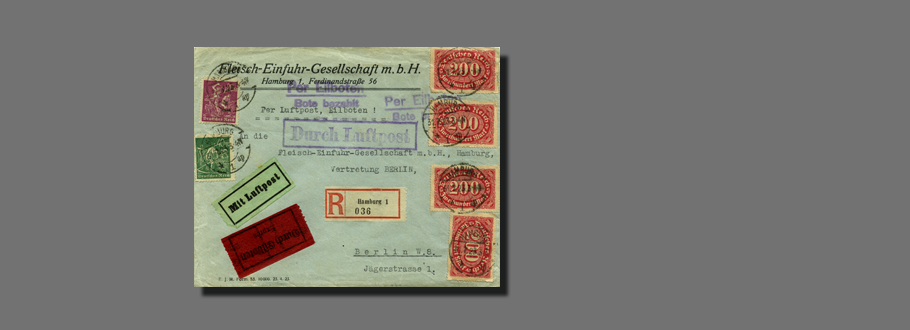
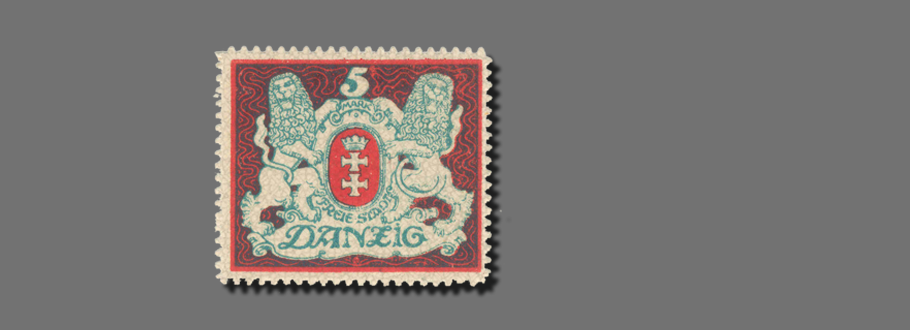
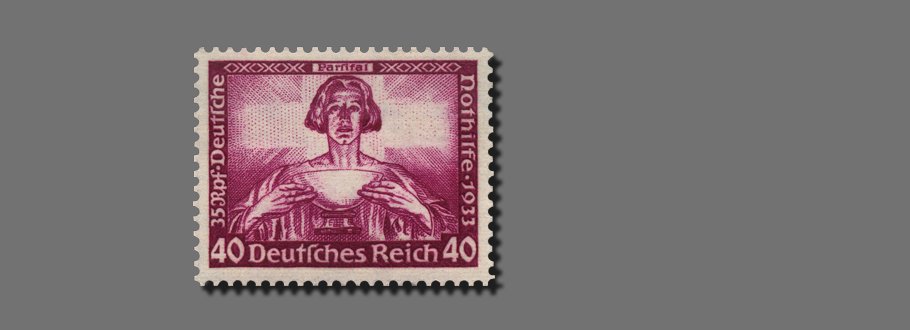
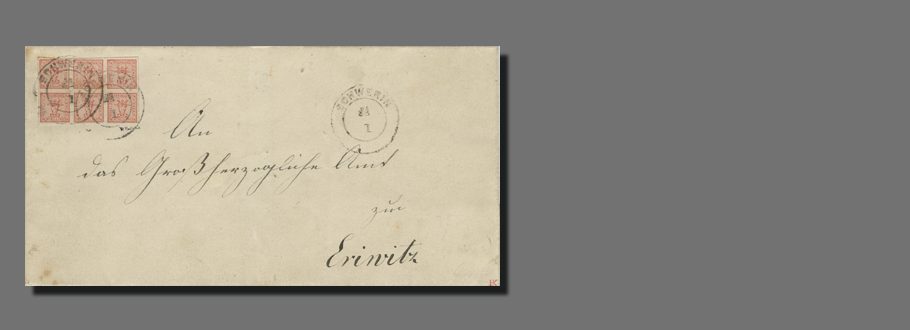
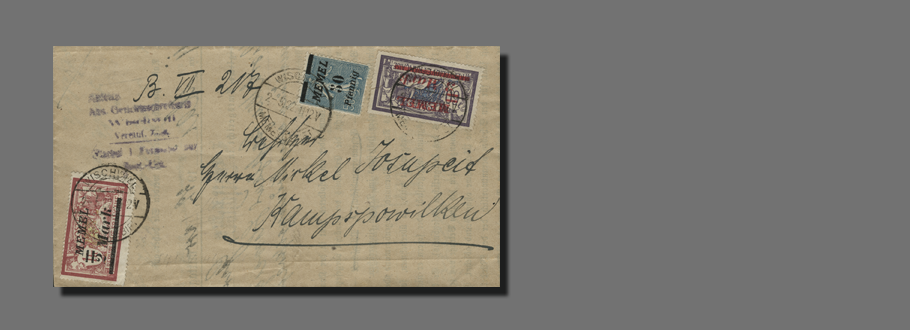
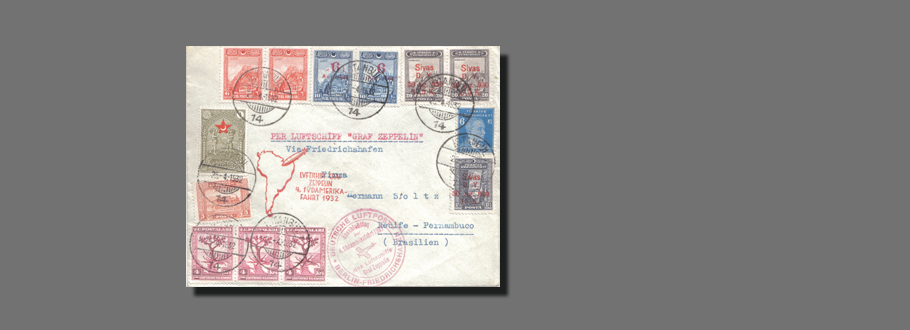
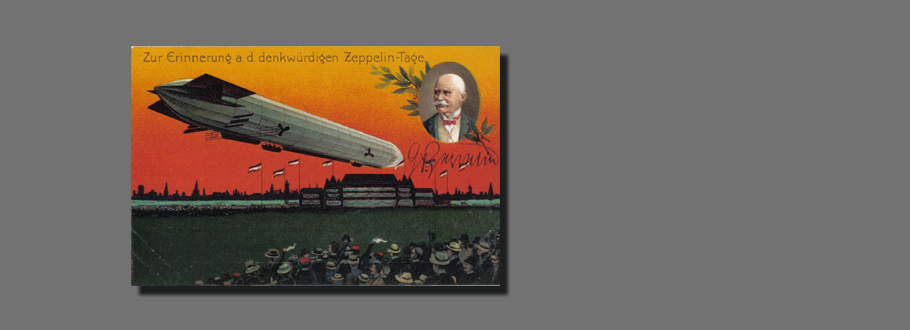

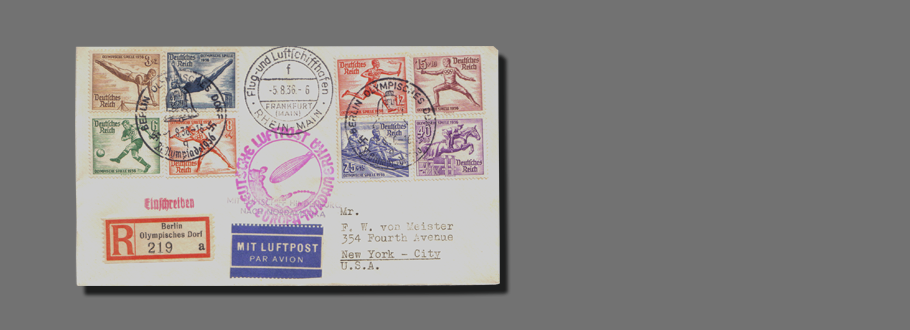
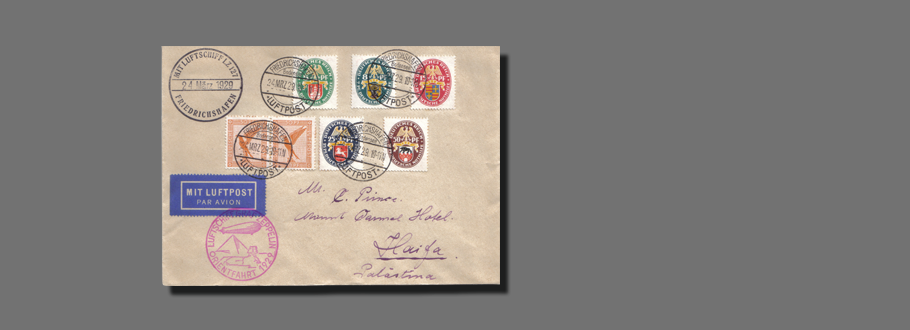
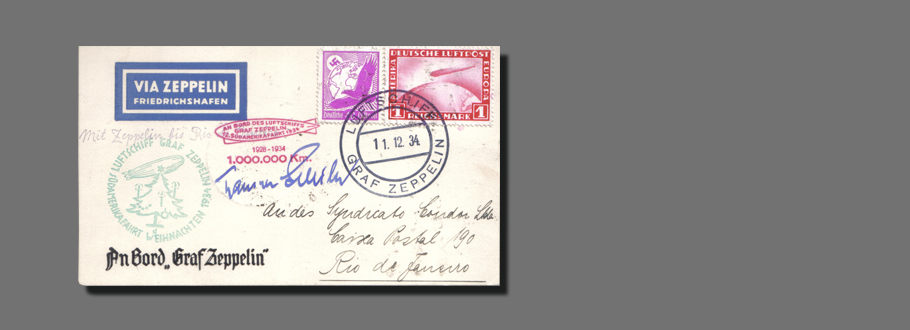
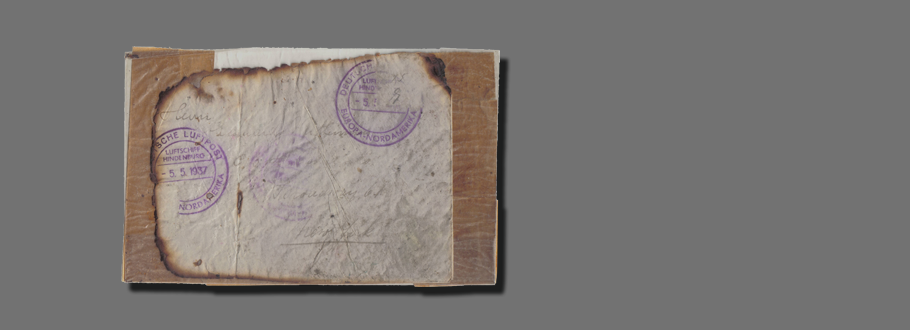
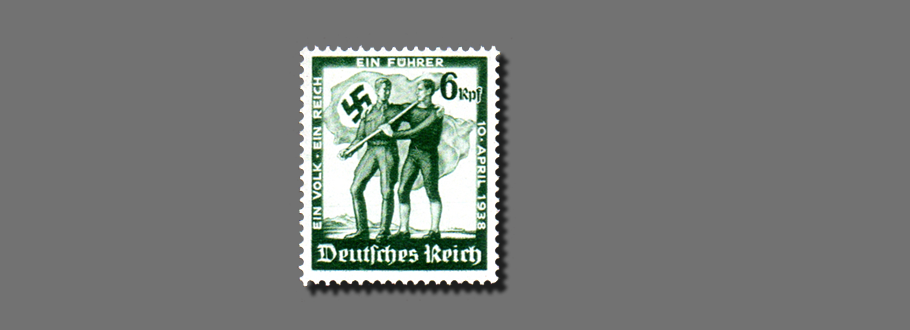
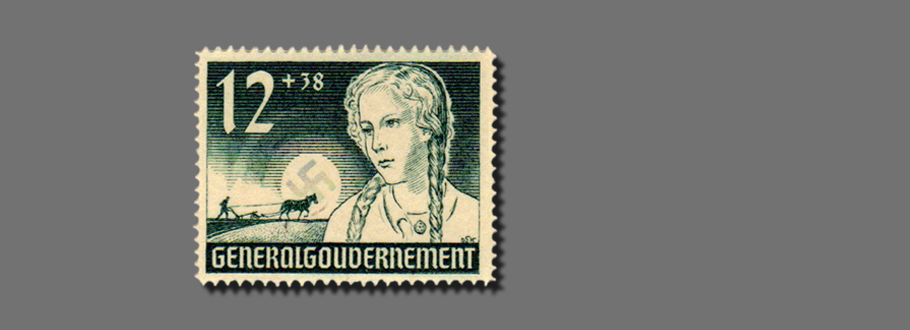
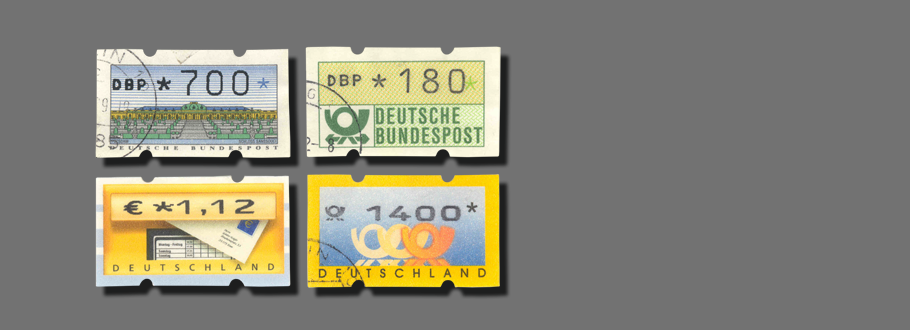
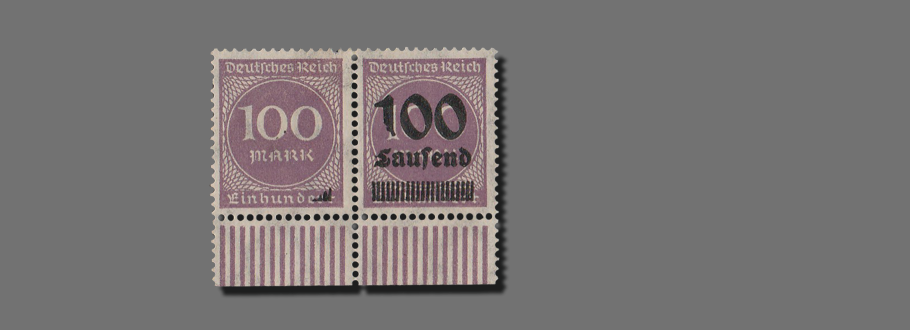

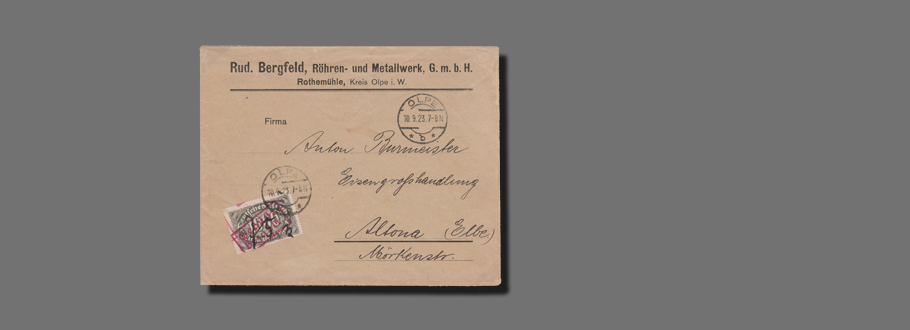
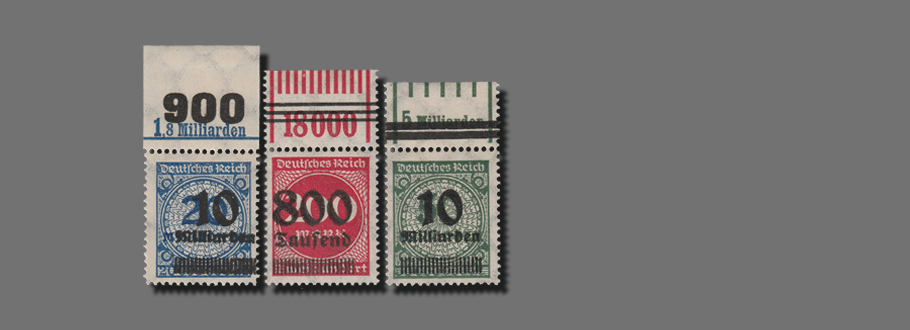
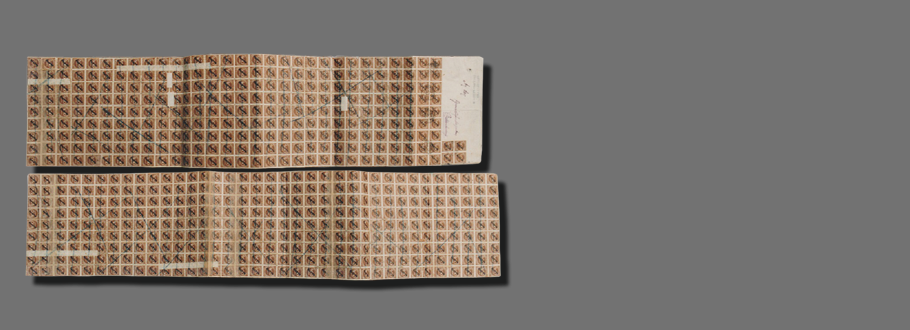

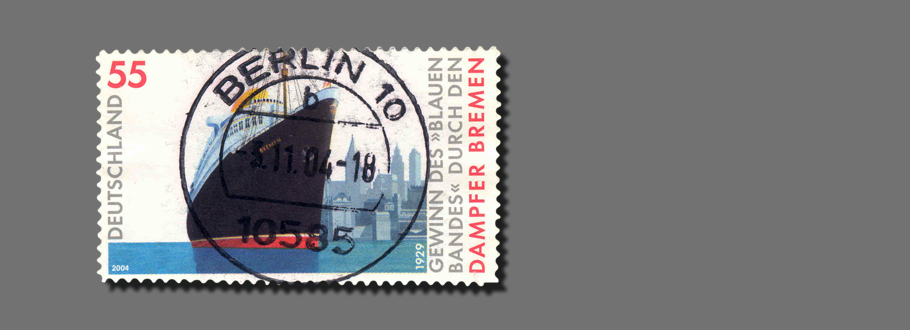

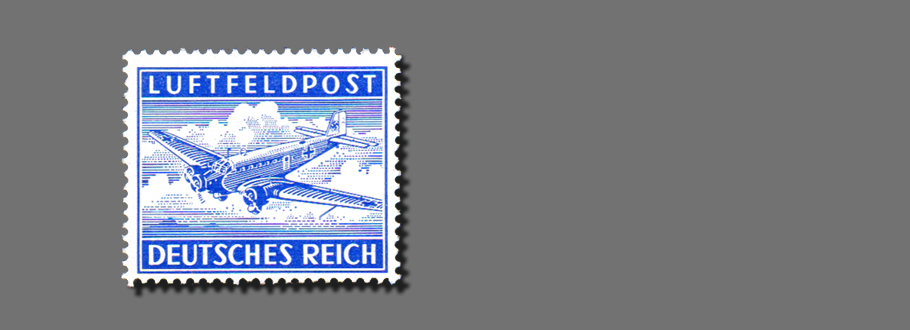
12Gr Copernicus memorial
The 12Gr value from the set of ‘buildings’ definitives depicts the statue of Nicolaus Copernicus standing in the courtyard of Krakow university. The university was closed by the Nazi administration and the Institut für Deutsche Ostarbeit (Institute for German Labour in the East) was housed in the former university library buildings. The purpose of the Institute was to undertake research into practical applications for the development of the new order in occupied Poland, including an investigation into the origins of Slavic peoples in the country.
‘Yacht issue’ stamps
The term ‘Yacht issue’ refers to postage stamps that bear the image of the Kaiser’s yacht, SMY Hohenzollern II. They were used in Germany’s colonies from 1900 and some were still valid for use up to the end of World War I. The stamps come in two formats, small for the low values and larger for the high values. The German colonies at that time were Cameroon, Caroline Islands, German East Africa, German New Guinea, German South West Africa, Kiauchau, Marianas Islands, Marshall Islands, Samoa and Togo.
10Pf postal stationery card .
This copy of a reply-paid 10Pf postal stationery card (Michel P62A) was returned from London post paid on 31 January 1908.
At the 1885 Convention of the Universal Postal Union in Lisbon prepaid postal cards with an attached reply-paid card were recognized for international mail. The addressee could write a reply on the reply half and post the card without charge.
A bit of fun
– a German President (Gustav Heinemann: Bundespräsident 1969-1974) “On Her Majesty’s Service”!
Germania 1¼M.
This copy of a Germania 1¼M (Michel 151) has a spectacular smudge at the back of the crown probably caused by a bit of foreign matter on the plate. There is a footnote in Michel regarding the 1920/21 Germania issue that there were many printing errors. The Reichsdruckerei faced many problems directly after the war not least in keeping up with the demand for the supply of Germania stamps with overprints for Allenstein, Danzig, Saargebiet & Memelgebiet so standards did slip compared with the pre-War printings.
1938 Anschluss propaganda card
Propaganda card celebrating the union of Austria with Germany in April 1938. The map depicts Austria as part of the new Greater Germany. The date at the foot of the card refers to the occasion of the ratification of the Anschluss law by Adolf Hitler during his stay in Linz, Austria.
2Z Hindenburg overprint
The first set of definitives created specifically for use in German-occupied Poland was the existing Hindenburg medallion stamps of Germany overprinted in black with new values and the inscription Deutsche Post Osten (German post in the East). Issued in December 1939, the stamps remained officially in circulation until September 1940.
5Z official stamp
The first set of adhesive stamps specially designed and printed for use in German-occupied Poland was a set of ‘officials’ issued in April 1940. As from the date of issue, the use of these stamps was in theory mandatory on official mail. However, this regulation was largely ignored by the administration and a great many mixed frankings occur.
Soldiers’ Mail
From May 1872 to 1919, most soldiers on active service were entitled to receive personal mail postage free, but all mail had to be inscribed:
"Soldatenbrief. Eigene Angelegenheit des Empfängers."
To make things easier for relatives, many labels were produced with the inscription already printed. These are from Württemberg, with a Germania frame and in similar colours to the 5 low values of the 1903/05 Official stamps, but with the word 'FREI' replacing the values, and the “Soldatenbrief” inscription replacing the ‘area codes’ & 'Official Free' wording.
A fantasy 10ct
A fantasy 10ct Alpenvorland Adria stamp taken from a set of 16 that were produced after the war. The designs and framework were based on the ‘Province Laibach’ set of 16 views of Slovenia issued in March 1945.
Occupation of Czechoslovakia
On the 15th July 1939, four months after the German Occupation of Czechoslovakia, 19 values of Czech definitives were overprinted by the German authorities “Böhmen u. Mähren’ with “Čechy a Morava” underneath. Bohemia and Moravia were the only two provinces left of the 1st Czechoslovakian Republic as the Sudetenland area had been ceded to Germany under the Munich Agreement while Slovakia and Carpatho-Ukraine had become independent upon German Occupation.
Foreign-workers’ mail
Due to a diminishing German workforce, the Nazi authorities became ever more reliant on labour from occupied territories. Thousands of workers were housed in camps across Germany. This postcard was mailed from an Ausländer-Lager (foreigners’ camp) in the Wartheland. This type of camp probably housed workers from different countries across Europe.
Catch-up flight
Registered mail carried from the Ostmark, German-occupied Austria, to New York on the liner ‘Europa’. The purple cachet signifies it was delivered by a special ‘feeder flight’ (Nachbringeflug) from Cologne to Cherbourg, which gave late mail the opportunity to catch the ship before it sailed for the USA.
Internal camp post
Residents of certain German POW camps organised their own postal systems to deliver mail around their camps. Registered Express letter from Woldenberg camp, franked with stamps designed, engraved and printed on site by prisoners.
Deutsch-Ostafrika
A registered letter sent locally within the town on 4 October 1910 franked with 4 and 15 heller stamps. The registration fee was 15 heller and the postage for usage after 15 July 1909 was 4 heller only for a local letter. The weight limit was also increased to 250 grams.
Deutsch-Ostafrika
A registered letter sent from Daressalam on 3 April 1909 to Göttingen franked with the 2½ and 20 heller ‘yacht stamps’ with watermarks. The registration fee was 15 heller and the postage for a letter up to 20 grams in weight to Germany was 7½ heller.
Deutsch-Ostafrika
A booklet pane with advertisement incorporated se-tenant with the stamps. There were three booklets and this pane comes from booklet A issued in 1911. Booklets A and B are scarce but Booklet C issued in 1913 which has se-tenant crosses is normally available.
Austrian Post Office
On the 5th April 1938, just over three weeks after the German Annexation of Austria (Anschluss), the Austrian Post Office (now German) decided on a trial overprint on four values of Austrian definitives of a swastika and new pfennig values. Although the trial printing was a success, it was then decided to abandon the idea and just use Austrian stamps until the 31st October 1938 at an exchange rate of 1pfg = 1½ groschen. All stocks of the overprinted stamps were then ordered to be destroyed.
Saar: Marian year
Three stamps: 5f red, 10f green and 15f blue were issued in the Saar on 14 August 1954 for Marian Year. December 1953 to December 1954 was called Marian Year to commemorate the centenary of the definition of the dogma of the Immaculate Conception of the Virgin Mary. There were social gatherings as well as cultural and charity events. This small sheet of Christmas seals, showing the stamps, was also produced.
Undercover mail
In order to communicate with civilians in occupied territories, the British organised mail services via covert Post Office Boxes based in neutral countries, such as Portugal. This express registered letter was posted from Warsaw to Post Box 512, Lisbon; from here it was passed on to Polish forces in Great Britain.
Christmas present
By the end of 1944 German and Italian troops were cut off from the mainland and it was becoming increasingly difficult to send mail home by airmail. As a ‘Christmas present’ to the troops on the islands of Rhodes, Kos, and Leros, it was decided, for morale purposes, to overprint redundant Italian 5ct Rhodes stamps “Weihnachten 1944” in black and give each soldier two stamps for airmail use, in addition to their usual allocation of official airmail stamps.
Saarland 1.10.57 Winter Charity
On 1.1.57, just over a year after the vote to return, Saarland became the eleventh state of West Germany. However the economic transition took a little longer – so Saarland continued to use the French currency for 2½yr.
This set was one of several issued with identical designs to a set issued in West Germany, but it had different values, due to the different currencies.
Perhaps the topic of ‘mining’ was chosen to welcome the Saar’s mainly mining community ‘back to the Motherland’.
10Z buildings definitive
High value stamp, issued on 20 April 1941, from the large set of ‘buildings’ definitives issued in German-occupied Poland (General Government). It features a line engraving of old Krakow with Wavel castle in the background, which was used as the headquarters for the Nazi administration.
Land Registry fee stamp
A 1912 issue 500MK German Land Registry fee stamp. Collecting revenue stamps can be particularly rewarding as many of them such as this representation of the personification of the German Empire Germania, have the most beautiful designs.
Commercial cover to Brazil
A commercial cover from Great Britain to Brazil franked 28/- including a PUC £1. The postal rate shows that the cover and its contents must have weighed up to four ounces. The red cachet confirms carriage by German airmail and the arrival date on the reverse of 13/7/36 by Zeppelin
Inflation – July 1923
Mail from Hamburg to Berlin on the last day of tariff period. Assuming this is printed matter, then it is overpaid by 50 Marks. If it were an inland letter it would be underpaid by 190 Marks. Both the receiving office and the delivery office have accepted it as correctly paid!
Danzig 5M definitive
The first large-format Danzig coat-of-arms issue of 1 August 1921 not only added three higher values – 5, 10 & 20 – to complete the range of definitive stamps available, but thereby introduced a more elaborate design akin to the coat of arms seen on civic documents, seals and the like. The designer Max Buchholz incorporated his monogram, MB, into the bottom centre of the stamp below the ‘N’ of ‘DANZIG’.
Deutsche Nothilfe 40+35Rpf
The top value in the set of nine stamps issued on 1 November 1933 in aid of the charity Deutsche Nothilfe. The set depicts scenes from operas by Richard Wagner as designed by Prof. Alois Kolb. Arguably one of the most beautiful sets of stamps ever issued by Germany. This stamp shows Parsifal transfigured, at the end of Act 3, as he holds forth the Holy Grail in the growing light from above.
Cover from Schwerin to Eriwitz
This letter has a block of six ¼ Schilling stamps to pay the required 1½ Schilling rate. The stamps were printed in sheets. Blocks of four stamps were separated by piercing (incorrectly described as rouletting), giving a separable stamp of 1 schilling. The four components of this stamp could then be separated by cutting to provide for various postal rates
Memel – Court writ of summons
This is official correspondence form a ‘County Court’ Amtsgericht. There were special arrangements for the payment of postage and the collection of a receipt of delivery for this type of official correspondence, a Zustellungsurkunde. The sender paid on posting the cost of outward postage, the charge for the postman obtaining the receipt of delivery and the return postage for the receipt.
South America flight 1938
A cover from Istanbul to Recife in Brazil, which was carried on the fourth flight of the 'Graf Zeppelin' to South America in 1932. The cover bears a special cachet for the fourth flight and a circular routing cachet, showing that it was flown in Germany via Berlin
Commemorating Zeppelin landings
A postcard issued in 1913, which shows a zeppelin landing in front of a group of people. It was issued as the caption says 'As a souvenir of the memorable Zeppelin days' to commemorate the Zeppelin landings in various cities throughout Germany.
First Graf Zeppelin flight to
South America
A postcard sent from Friedrichshafen on the first flight to South America of the 'Graf Zeppelin. The card is franked with the two special stamps issued for this flight. The pictorial cachet for the flight shows the airship flying past Sugar Loaf Mountain and a palm tree in Rio di Janeiro.
Olympic village to New York
A complete set of the 1936 Berlin Olympic stamps used on a registered cover to New York City. The cover was posted in the Olympic village, flown to Frankfurt am Main and then carried on the airship 'Hindenburg' on its sixth flight to North America
Orient Flight around the Eastern Mediterranean
A cover franked with the complete set of the 1928 Charity stamps and carried by the 'Graf Zeppelin' on its Orient Flight around the Eastern Mediterranean. This was the first time that a pictorial cachet was used on a Zeppelin flight
1934 Christmas flight to South America
A card posted on board the 'Graf Zeppelin' on the Christmas flight of 1934 to South America. The card bears the flight cachet and a supplementary cachet indicating that the airship had flown one million kilometres between its launch in 1928 and 1934. It is signed Watch Officer, Hans von Schiller
Last flight of the Hindenburg
This tatty looking envelope with charred edges, contained in its officially sealed glassine packet, is one of the 181 items of mail, destined for New York, which were recovered from the wreck of the 'Hindenburg' following the disaster at Lakehurst,
NJ in May 1937.
1938 Anschluss commemorative
Postage stamp issued simultaneously in Austria and Germany to commemorate the 1938 Anschluss (union with Germany). It depicts German and Austrian citizens united below a Nazi banner. It was designed by Professor E. Puchinger whose initials appear at the foot of the Austrian printing.
First Anniversary of General Government
12Gr value from the set of stamps commemorating the First Anniversary of the General Government, the term used to describe German-occupied Poland. The design is based on a portrait made by the artist Otto Engelhardt-Kyffhauser of a young ethnic German immigrant, Marie Eppler, who was relocated from Galicia to repopulate the incorporated territories of Western Poland.
FRAMA ‘Automat’ machine stamps
These variable-denomination vending-machine stamps started appearing in West Germany in early 1981 and collectors soon got to work!
Missing inflation overprint
The large volume of stamps required during the hyper-inflation period lead to poor quality control with various errors slipping through. This pair of 100 Mark stamps from March 1923 was overprinted in September 1923 at 100,000 Marks. For some reason the overprint on the left stamp is almost completely missing.
1 Billion Mark stamp
During the inflation period, some stamps were produced with serrated roulettes instead of perforations. This 50 Millarden stamp was the highest value inflation stamp issued – note the column value indicator of 1 Billion Marks – in 1923 a billion was a million millions, not 1000 million as accepted today!
Stamp shortage at Olpe
During the hyper-inflation period, cash payments were allowed when stamps were not available. A handstamp was normally used to indicate payment, but some offices used labels instead. At Olpe, low-value stamps were used, hand-stamping them ‘cash paid’ and writing the amount paid on the stamp (100,000 Marks in this case).
Regional post-office overprints
During the Hyper-inflation in 1923, the Government Printing works in Berlin were unable to cope fully with the huge demand. The Reich Ministry of Posts authorised regional post offices to organise the over-printing of selected issues. Many of these over-printings can be identified from the overprint in the top margin.
Left to right:
Stettin - Large numbers
Breslau - Three thin lines
Munich - Two thin bars
625 stamps used on one letter
The shortage of stamps during the hyper-inflation period led to large amounts of low-value stamps being used to pay the postage. For this official letter, 625 stamps of the 400 Mark value were used to pay the postage of 250,000 Marks!
Top - Front
Bottom - Back
DDR 225th anniversary of the birth of Mozart (1756-1791)
German stamps can be a rich resource for thematic collectors. There are many connected with music for example.
Bundesrepublik 75th anniversary of the ‘Blue Riband’ by the passenger ship ‘SS Bremen’
This stamp was issued on 8 July 2004. The SS Bremem won the ‘Blue Riband’ for her first time in 1929, an accolade marking the record highest speed for a passenger liner crossing the Atlantic Ocean westbound in regular service. The ship is also interesting to collectors of ‘catapult’ mail.
DDR Leipzig Spring Fair
These two stamps, issued on 5 March 1950, were the last in a series of similar wonderfully detailed stamps issued in connection with the historic Leipzig trade fairs. The previous sets were issued whilst Germany was under postwar Allied occupation.
Luftfeldpost
The German campaign to invade Russia in 1941 stretched supply lines to the limit. The only viable solution was to inaugurate an airmail service to carry letters and cards to and from the Eastern Front. Each item of mail had to carry a blue concession label that depicts the aircraft selected for the service, the sturdy JU 52.
<
>

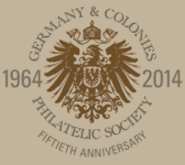
The year 2014 marked the 50th anniversary of the first year of operation of the Germany & Colonies Philatelic Society following the amalgamation of the Germany & Colonies Stamp Club (established 1947) and the Stockton German Study Group (1960).
The G&CPS celebrated its inaugural year in 1964 with the first Germania Posta philatelic exhibition held in Stockton.
STUDY GROUPS
Third Reich
The Society’s largest and most active study group welcomes all collectors with a serious interest in the postal history of Germany and the German-occupied territories during the period 1933 to 1945. The Group’s quarterly News Sheet aims to assist the beginner and to help the more advanced collector to keep up with the latest information and research.
The last published News Sheet can also be accessed here as a pdf file.
Here is a pdf file of the index to all the articles so far available in the Study Group’s News Sheets from 1974 to 2020.
Meetings 12 noon for lunch with displays 13.00-16.00:
The Civil Service club, 13-15 Great Scotland Yard,
London SW1A 2HJ. Tel 0207 930 4881
Forthcoming meetings
18 April 2026
Berlin Olympics
Tony Bosworth
25 July 2026
Details TBA
17 October 2026
Details TBA
ASSOCIATED GROUPS
Danzig
The Danzig Study Group of the UK was launched on 1 January 2007. I hope that members of the new group will share their knowledge and enjoyment of their collections with me in the pages of a quarterly, full colour, A4-sized journal The Danzig Philatelist, on any aspect of Danzig/Gdańsk philately encompassing postage or revenue stamps and postal history including postcards, postal stationery, documents and relevant ephemera of any period.
Any back issue of ‘The Danzig Philatelist’ can be supplied as a print-on-demand copy to members or non-members. Also a list of the contents of each issue can be viewed here. Also a full index to issues 1-72 (Jan. 2007 – Dec. 2024) can be viewed here.
UK: £18.00 – cash or sterling cheque payable to ‘P.G.H. du Boulay’ or by bank transfer
Europe: £28 or €35 or 150zł; Rest of World - £33 or US $45
Cash in US dollars, Euros or złotys, or International Money Order payable to ‘P.G.H. du Boulay’
or by bank transfer to either Euro or sterling account - enquire for details.
Transfers can be made simply and cheaply through such platforms as Wise or Western Union.
Giles du Boulay, 8 Malvern Road, Aylesbury, Bucks
HP20 1QF, UK
Tel. [0044] (0)1296 488703
E-mail: giles.duboulay@btinternet.com
Stadtposts Collectors
The city posts of Germany were formed as a result of the postal acts of the North German Confederation in 1867 and the Federal Act passed in 1871. This latter act established the Reichspost at the time of the Federation of the German States and provided a monopoly for the State on the delivery of mail between towns as the Reichspost was not concerned with inner city deliveries, nor with the delivery of parcels, printed papers, unsealed letters and postcards.
Such a vacuum allowed private enterprise to provide a service, which became increasingly necessary as the industrial cities expanded at the end of the 19th century. The postal authorities did not foresee the extent to which it would be used.
A total of 250 private postal companies operated in 164 towns and cities in Germany before they were closed down by the government on 1 April 1900.
For the stamp collector Privatpost or Stadtpost issues offers a wide selection of stamps and covers - some very simple whilst others have very sophisticated designs and unending interest and discoveries.
Membership of the Stadtpost Study Group is FREE and members will receive a quarterly Journal by email. To become a member please apply by email to: stadtpostcollector@gmail.com
German Colonies Collectors Group
The German Colonies and Post Offices abroad provide a wonderfully rich and varied collecting area. The German Colonies Collectors Group (GCCG), based in the USA, is a Study Group of the Germany Philatelic Society, an Associated Group of the G&CPS, and an Affiliate of the APS.
The GCCG was founded in 1968, and has been in continuous operation since 1973. We have more than 220 members, principally in the United States, Canada, Germany and the UK. We publish our quarterly journal, VORLÄUFER, in English. Each 36-page issue combines original research, articles, translations from less accessible journals, and regular features including selected auction realizations, reports on books and exhibitions and much more. We also publish a cumulative index (back to 1984) every 18 months. Membership costs $20 (USA & Canada) and 24/$34 (elsewhere).
A sample copy of VORLÄUFER may be obtained either from A. Lavar Taylor, 6 Hutton Centre, Suite 880, Santa Ana, CA 92707-0516 lavartaylor@cox.net or Oliver Wyrtki, 203 Mill Crossing, Yorktown, VA 23693 okeeper@hotmail.com